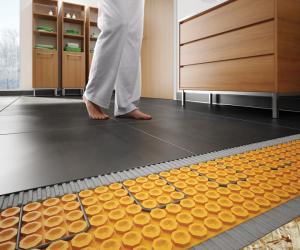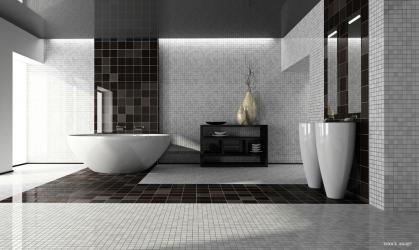Radiant-heat flooring is rapidly becoming a popular choice for home remodelers. When compared with a traditional forced-air system, it requires no visible heating units and distributes heat evenly, all while being quieter and often more energy efficient.
Radiant heat is not new technology. Radiators filled with heated water have been used to heat buildings for more than a century. Moving the heating element to the floor is even more efficient because the warm air rises naturally and circulates throughout a room due to convection.
For homes already equipped with forced-air heating, a supplementary electric radiant floor is a more economical solution than installing a whole-house hydro-radiant system, especially when heating small spaces such as a bathroom or bedroom.
The DITRA-HEAT system by Schluter Systems uses an uncoupled plastic and fabric “waffled” membrane instead of sand and cement or concrete board, which effectively separates the floor from the structure, allowing independent movement between the substrate and the floor. This prevents stress on the tile and eliminates any chance of cracking. It also produces a much lighter load for a housing structure and is the lightest underlayment in the industry at 2 ounces per square foot.
Since the tile is installed directly over wiring, heat transfer is maximized and installation is quick and simple. The wire is installed directly into a channel in the middle of the membrane, affording precise fitting and providing structural warranty. This also offers a high degree of control over how much space is heated by creating customized heating zones. A programmable, digital thermostat controls the temperature.
The DITRA-HEAT system is also waterproof, allowing worry-free installation in showers, bathrooms and kitchens.
“The experience of heated tile is similar to that of heated seats in a car,” says Mitch Tully with Trends in Tile. “Before you try them, it's a luxury you’ve likely never considered, but once you’ve tried them, you'll never give them up.”
The DITRA-HEAT system can be found locally at Sunderland Brothers Company, Henry Kitchen & Bath and Trends in Tile.







